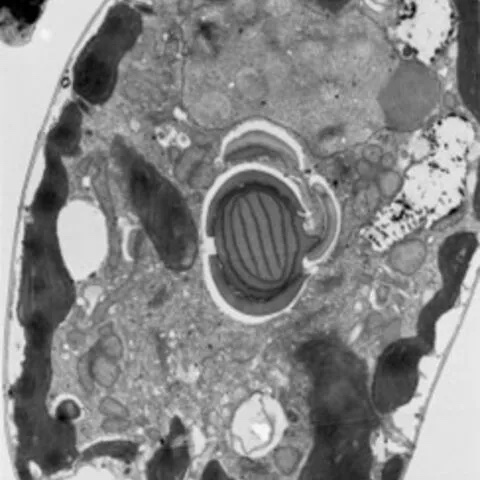Chloroplast biology and coral bleaching
Chloroplast biology and coral bleaching
We have long been interested in the chloroplast genome, which is a relic of the endosymbiotic evolution of chloroplasts from photosynthetic bacteria. Most recently, we have been interested in the chloroplast genome of dinoflagellates. These organisms are ecologically very important in their own right, and as symbionts inside coral animals. They provide the coral with photosynthate, but under some conditions the symbiosis breaks down and the dinoflagellates are expelled – this is coral bleaching.
Figure 1: Electron micrograph of the dinoflagellate Amphidinium carterae, one of the most widely used lab strains. There are chloroplasts around the edge of the cell, and a prominent pyrenoid – the region specialised for CO2 fixation – in the centre. Figure from Edmund Nash, PhD thesis, University of Cambridge.
We and others have showed that the dinoflagellate chloroplast genome is fragmented and highly reduced. Most of the genes usually found in chloroplasts have been relocated to the nucleus. The remainder are on small, plasmid-like molecules called minicircles – usually with a single gene on each. We are studying the biology of this system – how the minicircles are retained, and genes expressed. However, for many years there was no reliable transformation system for dinoflagellates. We recently developed one, using the minicircles as the basis for shuttle vectors.

Figure 2: Expression of chloramphenicol acetyl transferase (CAT) in genetically modified dinoflagellate chloroplasts. The figure shows (left to right) brightfield image of dinoflagellates, chlorophyll fluorescence showing the location of chloroplasts, fluorescent detection of CAT, merged image showing CAT in the chloroplasts. Figure from Nimmo et al. (2019) eLife doi.org/10.7554/eLife.45292
This opens the possibility for many exciting studies on dinoflagellate photosynthesis – understanding what goes wrong in coral bleaching, and how we might avoid it.
More information:
“Genetic transformation of the dinoflagellate chloroplast” Nimmo IC, Barbrook AC, Lassadi I, Chen JE, Geisler K, Smith AG, Aranda M, Purton S, Waller RF, Nisbet RER, Howe CJ. eLife (2019) 8:e45292. doi.org/10.7554/eLife.45292
“Breaking up is hard to do: the complexity of the dinoflagellate chloroplast genome” Barbrook AC, Howe CJ, Nisbet RER. Perspectives in Phycology (2019) 6:31-37. DOI: 10.1127/pip/2018/0084

